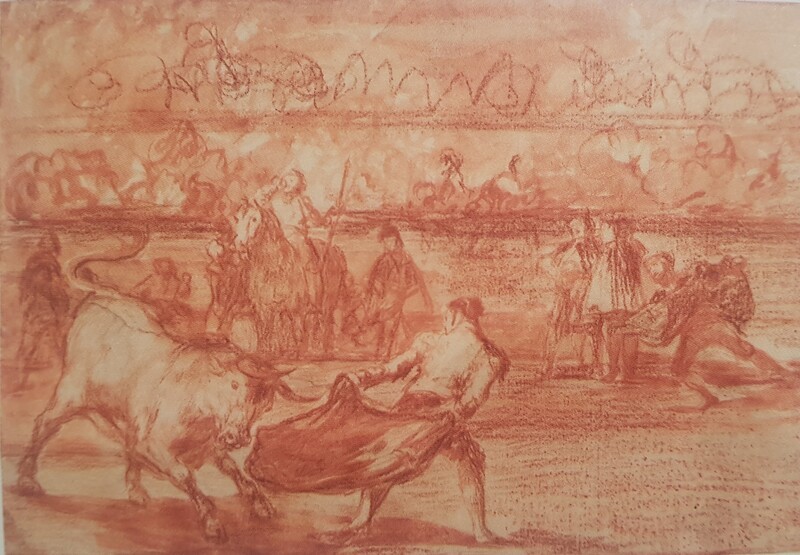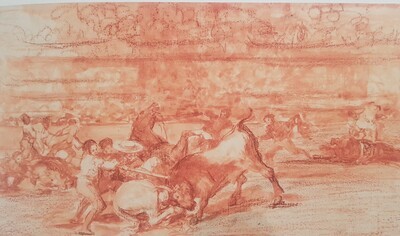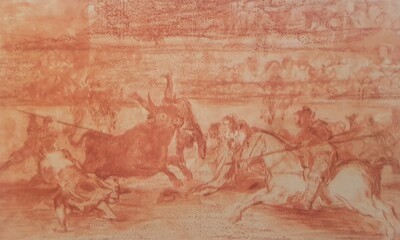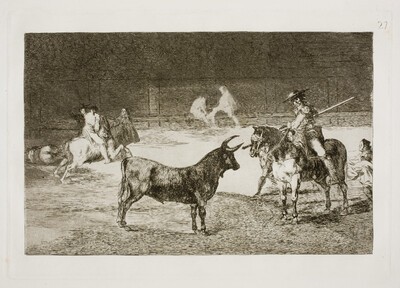- Cronología
- Ca. 1814 - 1816
- Ubicación
- Hamburger Kunsthalle, Hamburg, Germany
- Dimensiones
- 193 x 295 mm
- Técnica y soporte
- Reconocimiento de la autoría de Goya
- Undisputed work
- Titular
- Hamburger Kunsthalle
- Ficha: realización/revisión
- 03 Oct 2021 / 22 Jun 2023
- Inventario
- (Inv. 38542)
- Otros títulos:
-
5 [...] (recto, lower left-hand side)
248 [adhesive envelope] (reverse, bottom)
See How the ancient Spaniards hunted bulls on horseback in the countryside.
Line of provenance: [José Atanasio Echeverría, Mexico]; Julian Benjamin Williams, Seville (d. 1866); John Wetherell (?) (d. 1865); Horatio / Nathan Wetherell (?) (until 1874); Frederick William Cosens, London (1874-1890); Sotheby's, London, auction of Frederick William Cosens' estates (11-21 November 1890); Bernard Quaritch Ltd, London (November 1890-July 1891); acquired by the Hamburger Kunsthalle on 14 July 1891.
This is one of the four preparatory drawings for Bullfighting and its Extensions held by the Hamburger Kunsthalle (28a, 32b, Ea and Ka) and one of the few of the series and its extensions not in the Prado Museum, Madrid.
See How the ancient Spaniards hunted bulls on horseback in the countryside.
Preparatory drawing for the print A bullfighter fighting from behind from the front (Bullfighting K). Here we see a bullfighter citing the bull from behind, in a very imaginative suerte. This main pair of bullfighter and bull are located in the foreground to the left, taking all the limelight, while the rest of the figures are located in the background, many of them in the same position as in the later engraving, although some will be eliminated to lighten the composition and make it easier to read. On the right is a group of labourers calling the bull and further to the back a picador on his mount in a different posture to the one he will later have in the engraving, where we see them leaning over his apparently injured horse. In the background we can see the barrier of the bullring and the bullrings with the audience.
The lighting of the scene is different from that of the engraving. It is notable for the mixture of techniques, sanguine and red ink wash, which facilitates the suggestion of movement. In this connection, Gassier links this study to three other preparatory drawings by Goya for prints in the series of the Tauromaquia and its extensions in which the same techniques are used (27a, 32b and 38a). Hofmann, for his part, points out that the red wash helps him to see the effect that the aquatint will have on the subsequent print. He also comments on the three groups in the drawing that contrast with the passive audience, which is sketched in. He also points out the existence of corrections in Goya's hand that allow us to see his creative process.
-
Hamburg1966
-
Goya. Das Zeitalter der Revolucionen. Kunst um 1800 (1980 – 1981)Hamburger KunsthalleHamburg1980
-
Hamburg1989
-
Hamburg2001
-
Dallas2014
-
Hamburg2019
-
1941pp. 185-193
-
1946pp. 177-216
-
BarcelonaTartessos-F. Oliver Branchfelt1946 (reed. 1951)
-
OxfordBruno Cassirer1964vol. II, 1964, p. 361, cat. 247
-
Vie et ouvre de Francisco de GoyaParísOffice du livre1970p. 281, cat. 1240
-
Barcelona1974p. 21
-
Dibujos de Goya, 2 volsBarcelonaNoguer1975pp. 424-425, cat. 287
-
MadridMuseo Nacional del Prado2001pp. 109-110
-
www.kunsthalle-karlsruhe.de, consulted 13-04-1013-04-10




